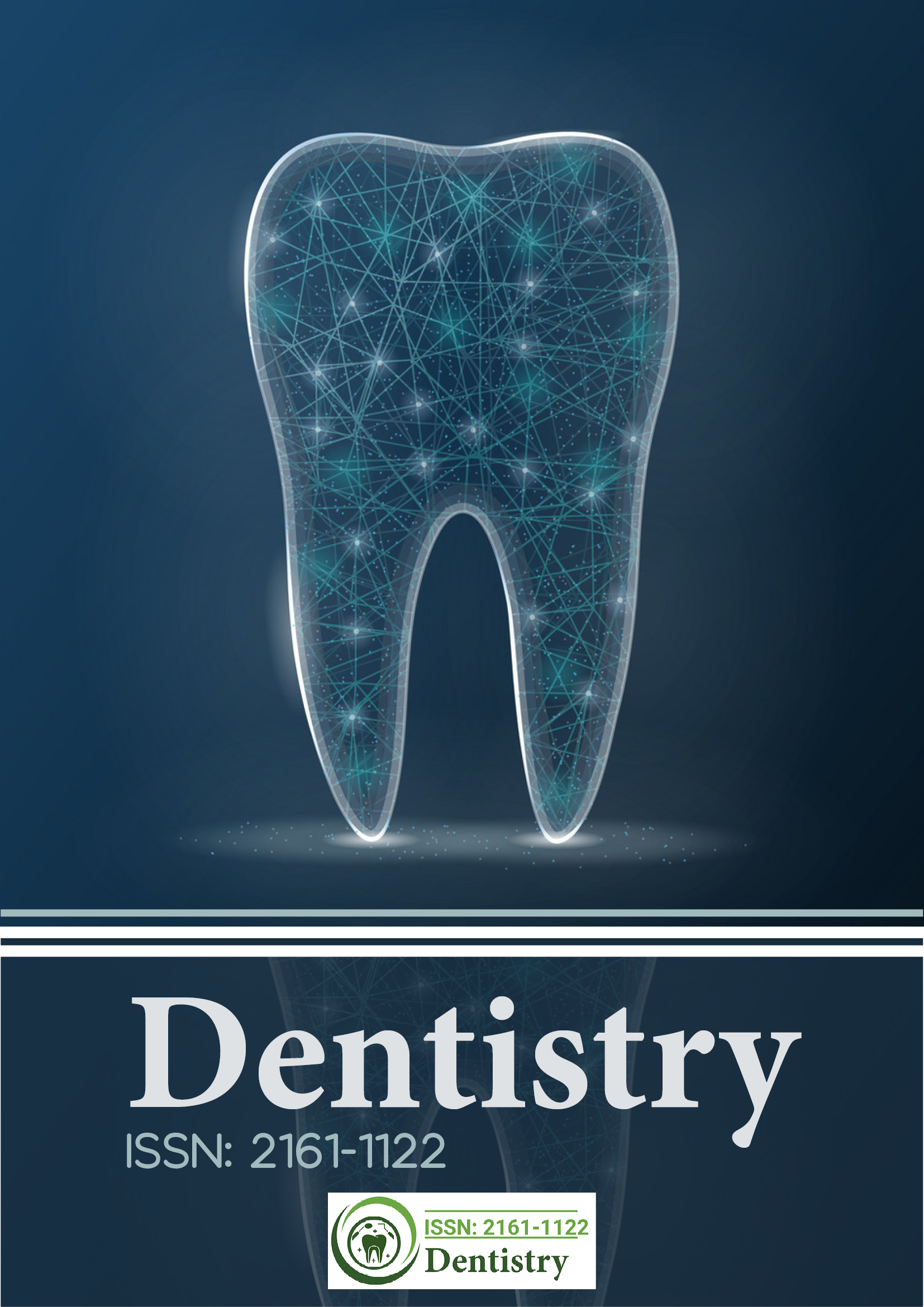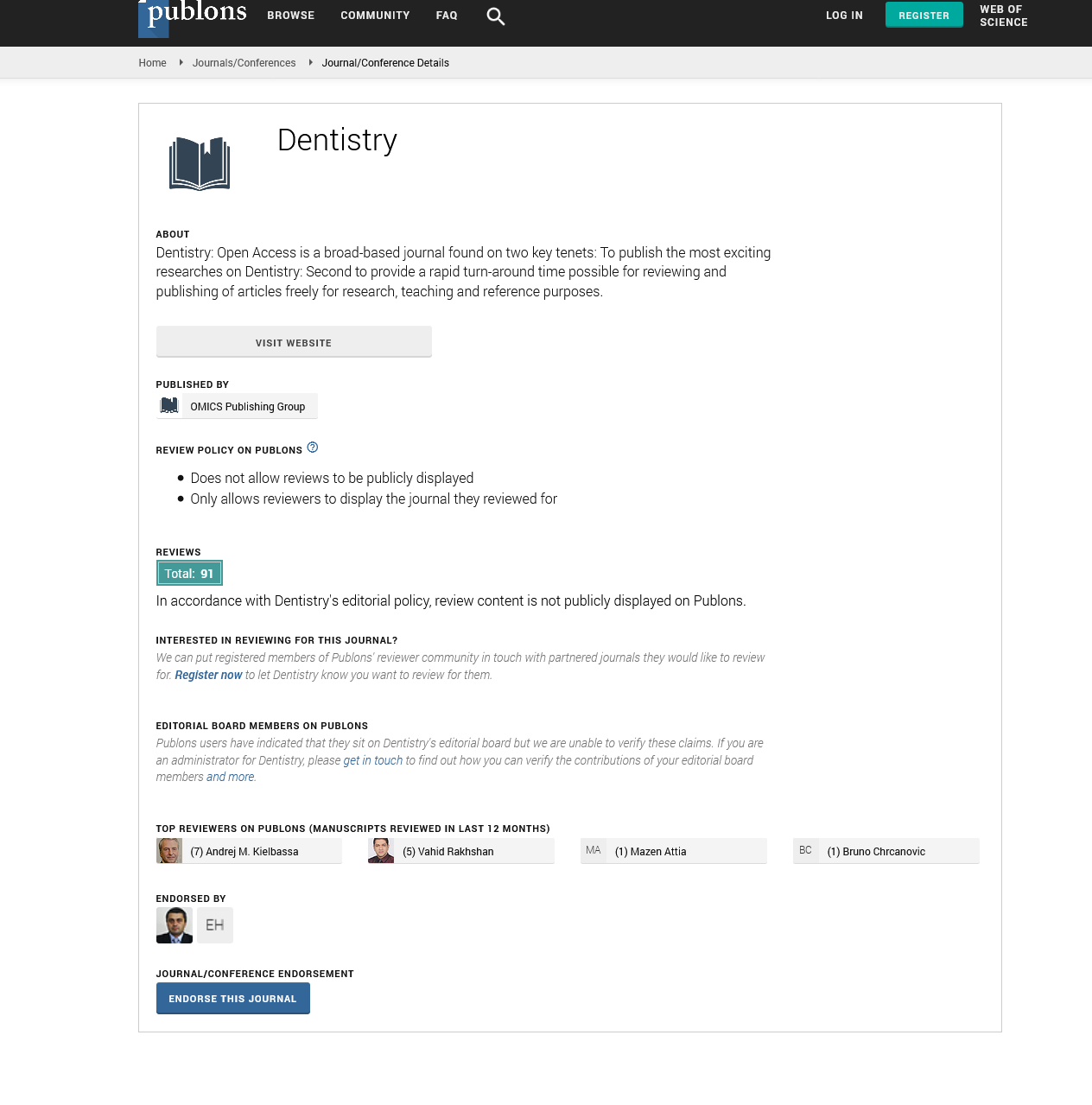Citations : 2345
Dentistry received 2345 citations as per Google Scholar report
Indexed In
- Genamics JournalSeek
- JournalTOCs
- CiteFactor
- Ulrich's Periodicals Directory
- RefSeek
- Hamdard University
- EBSCO A-Z
- Directory of Abstract Indexing for Journals
- OCLC- WorldCat
- Publons
- Geneva Foundation for Medical Education and Research
- Euro Pub
- Google Scholar
Useful Links
Share This Page
Journal Flyer

Open Access Journals
- Agri and Aquaculture
- Biochemistry
- Bioinformatics & Systems Biology
- Business & Management
- Chemistry
- Clinical Sciences
- Engineering
- Food & Nutrition
- General Science
- Genetics & Molecular Biology
- Immunology & Microbiology
- Medical Sciences
- Neuroscience & Psychology
- Nursing & Health Care
- Pharmaceutical Sciences
Commentary - (2025) Volume 15, Issue 2
Factors Contributing to Multiple General Anesthesia in Pediatric Dental Care
Konrad Krieg*Received: 26-May-2025, Manuscript No. DCR-25-29701; Editor assigned: 28-May-2025, Pre QC No. DCR-25-29701 (PQ); Reviewed: 11-Jun-2025, QC No. DCR-25-29701; Revised: 18-Jun-2025, Manuscript No. DCR-25-29701 (R); Published: 25-Jun-2025, DOI: 10.35248/2161-1122.25.15.727
Description
Dental treatment under General Anesthesia (GA) is commonly required for young children with extensive dental needs, behavioral challenges, or medical conditions that limit cooperation in the clinic. Some children require repeat GA sessions due to new dental pathology, recurrent decay, or incomplete prior treatment. This review examines restorative, patient-related and clinical factors associated with repeat GA in pediatric dentistry. Evidence highlights the influence of treatment complexity, patient age, caries risk, oral hygiene and systemic conditions. Strategies to minimize repeat anesthesia include comprehensive treatment planning, preventive interventions, caregiver education and regular follow-up. Ethical and safety considerations, clinical implications and future directions are also discussed.
General anesthesia provides a safe and effective method to deliver dental care for children unable to cooperate in conventional settings. GA allows completion of comprehensive dental procedures in a single session, reducing stress for patients and caregivers and improving treatment quality. Despite these advantages, repeat GA is sometimes necessary due to recurrent caries, new lesions, or failure of previous restorations. Understanding factors that contribute to repeat anesthesia helps clinicians plan interventions that optimize long-term outcomes, reduce risks and enhance patient safety.
General anesthesia in pediatric dentistry
GA is indicated for children with severe anxiety, cognitive or developmental disabilities, uncooperative behavior, extensive dental decay, or complex treatment needs. Younger children and those with multiple cavities or significant oral disease often benefit from GA to complete comprehensive treatment efficiently. Additionally, children with medical conditions that complicate routine care may require GA to ensure safety and adequate pain control. Recognizing appropriate candidates for GA is fundamental to reducing the likelihood of incomplete treatment and the need for repeat sessions.
Factors influencing repeat general anesthesia
The type and extent of restorative procedures performed during GA significantly impact the potential for repeat anesthesia. Large restorations, multiple extractions, pulp therapy and full-mouth rehabilitations are associated with higher rates of retreatment. Restoration longevity is critical; temporary materials or restorations prone to failure may necessitate additional treatment. Incomplete pulp therapy or partial restorations can lead to recurrent disease. The choice of restorative materials, such as glass ionomer cements, composites and stainless steel crowns, influences durability and resistance to caries recurrence. Children with more complex restorative needs have a higher probability of requiring repeat GA.
Patient-related factors
Patient-specific characteristics play a major role in repeat GA. Younger age at first GA is associated with higher recurrence risk due to limited cooperation and increased caries activity. High caries risk, influenced by diet, oral hygiene and fluoride exposure, contributes to new lesions. Behavioral factors, including limited compliance with home care, increase vulnerability. Medical conditions affecting salivary flow, immunity, or tooth development may also elevate risk. Socioeconomic factors, such as access to dental care, parental education and family support, further influence oral health outcomes. Recognizing high-risk patient profiles allows clinicians to implement preventive strategies and reduce repeat anesthesia.
Clinical and environmental considerations
Clinical and environmental aspects beyond restorative and patient factors impact repeat GA. Regular follow-up visits enable early detection and management of new lesions. Preventive interventions, including fluoride varnishes, sealants and dietary counseling, are effective in reducing recurrence. Active parental involvement in daily oral hygiene routines improves outcomes. Consistent care within a dental home ensures continuity and monitoring of restorations. Comprehensive management during the initial GA session, combined with preventive strategies, may decrease the need for subsequent anesthesia.
Outcomes of repeat general anesthesia
Repeat GA affects both patients and caregivers. Multiple sessions increase exposure to anesthetic agents, raising concerns about potential neurodevelopmental effects in very young children. Psychological effects include stress and anxiety related to repeated hospital visits and separation from caregivers. Families also face financial and logistical burdens due to additional appointments. Despite these challenges, careful planning and preventive measures can minimize risks while ensuring children receive necessary dental treatment safely and effectively.
Strategies to reduce repeat general anesthesia
Several strategies have been identified to reduce repeat GA. Comprehensive treatment planning during the initial session is essential, including full-mouth rehabilitation and addressing all active lesions. Use of durable restorative materials, such as stainless steel crowns and composite restorations, enhances longevity. Preventive interventions, including fluoride varnishes, sealants and parental education, reduce caries recurrence. Regular follow-up allows early intervention for failed restorations or new lesions. These approaches collectively reduce the likelihood of repeat anesthesia and promote long-term oral health.
Repeat general anesthesia in young children is influenced by restorative, patient-related and clinical factors. Children with extensive decay, complex restorative needs, high caries risk, or behavioral challenges are more likely to require additional GA sessions. Comprehensive initial treatment, durable restorations, preventive interventions, caregiver education and consistent follow-up reduce the risk of repeat anesthesia. Understanding these factors supports clinicians in providing safe, effective and long-term oral healthcare for pediatric patients while minimizing exposure to repeated anesthesia.
Citation: Krieg K (2025). Factors Contributing to Multiple General Anesthesia in Pediatric Dental Care. J Dentistry. 15:727.
Copyright: © 2025 Krieg K. This is an open-access article distributed under the terms of the Creative Commons Attribution License, which permits unrestricted use, distribution, and reproduction in any medium, provided the original author and source are credited.

